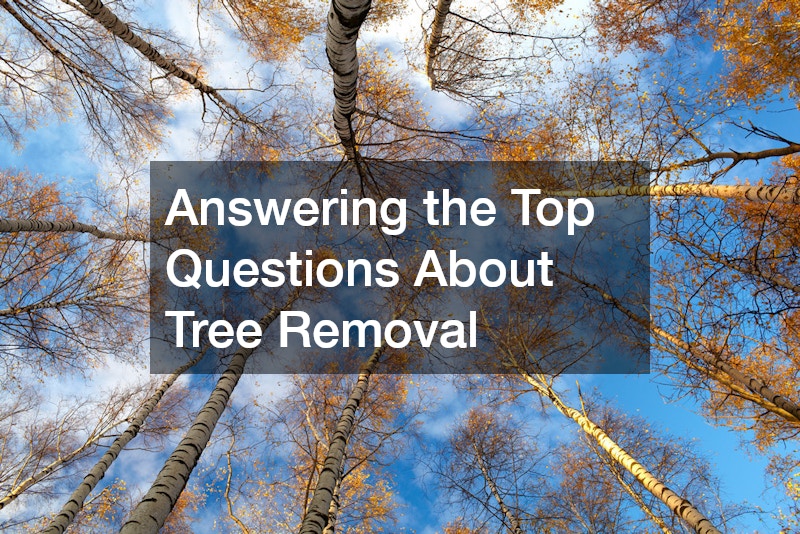Tree removal is sometimes necessary to maintain safety, protect property or make way for new developments. Whether you have a hazardous tree on your property or simply need more space, it’s important to understand the process and what to expect. To help, we’ve answered some of the most common questions about tree removal and when to call professional tree services.
When Should a Tree Be Removed?
There are several reasons a tree may need to be removed, including:
- Safety concerns – A tree that is dead, diseased or structurally unstable can pose a serious risk to people and property.
- Storm damage – Strong winds, heavy rain and lightning can weaken or damage trees, making them dangerous.
- Encroachment on structures – Trees growing too close to homes, fences or power lines can cause damage and may need to be removed.
- Disease or pest infestations – Some trees suffer from fungal infections, rot or pests like termites, which can spread to other plants.
- Landscaping or construction projects – If a tree is in the way of a planned renovation or development, removal may be necessary.
A professional tree services provider can assess whether removal is the best option or if trimming and maintenance can help.
Do I Need Council Approval to Remove a Tree?
In many cases, yes. Local councils have regulations about tree removal to protect the environment and preserve urban greenery.
Some trees are protected under preservation orders, meaning you need approval before cutting them down.
Council approval requirements vary depending on the tree’s size, species and location. If you’re unsure, check with your local council or hire tree services familiar with local regulations to handle the process for you.
How Much Does Tree Removal Cost?
The cost of tree removal depends on several factors, including:
- Tree size and height – Larger trees require more labour and equipment, increasing the price.
- Location and accessibility – Trees close to buildings, fences or power lines require careful removal, which can add to the cost.
- Tree condition – A dead or unstable tree may be more difficult to remove safely.
- Stump removal – Some services include stump grinding, while others charge extra for it.
Tree services typically provide quotes based on these factors. Getting multiple quotes can help ensure you get a fair price.
What’s Involved in the Tree Removal Process?
Tree removal is a detailed process that requires expertise and specialised equipment. Here’s what to expect:
- Assessment – A professional inspects the tree to determine the safest removal method.
- Council approval (if needed) – If required, permits must be obtained before work begins.
- Cutting and removal – Depending on the size and location, tree services may use climbing techniques or cranes to remove branches and sections safely.
- Stump grinding – If you don’t want a stump left behind, stump grinding can level it with the ground.
- Clean-up – Professional tree services usually remove all debris and leave the area tidy.
Is Tree Removal Dangerous?
Yes, tree removal is a hazardous job that should be left to professionals. Working with chainsaws, climbing trees and dealing with heavy branches all carry risks. Experienced tree services have the necessary training, equipment and insurance to perform the job safely. Attempting DIY tree removal can lead to property damage, injury or even legal consequences if the tree falls in an unexpected direction.
What Happens to the Tree After It’s Removed?
Once a tree is removed, the wood can be used in various ways. Depending on the service provider, you may have options such as:
- Mulching – Many tree services chip the branches and smaller pieces into mulch, which can be used in gardens.
- Firewood – Larger sections of the tree can be cut into firewood.
- Recycling – Some companies recycle wood for furniture, timber or composting.
If you have specific preferences for the tree’s disposal, discuss them with your tree services provider before removal.
Can I Remove a Tree Myself?
While it’s legal to remove small trees on private property in many areas, larger trees should always be handled by professionals. Tree removal involves significant risks, including falling branches, equipment mishandling and property damage. Hiring professional tree services ensures the job is done safely, efficiently and in compliance with local regulations.
Tree removal is sometimes necessary for safety, property protection or landscaping projects. Understanding the process, costs and legal requirements can help you make informed decisions. Whether you need to remove a hazardous tree, apply for council approval or maintain your existing trees, professional tree services can provide expert assistance. By investing in regular tree care, you can prevent issues and keep your outdoor space safe and attractive.
.

